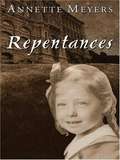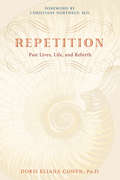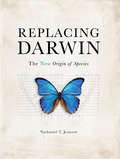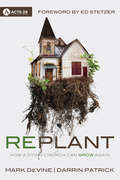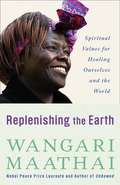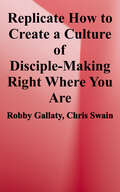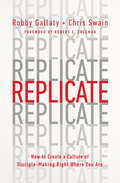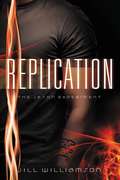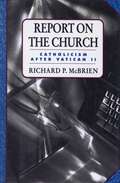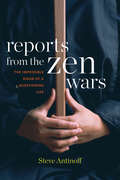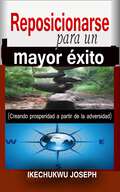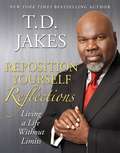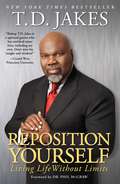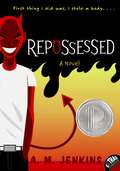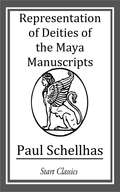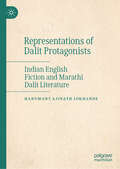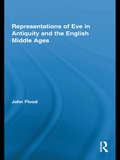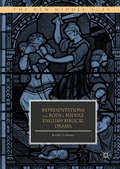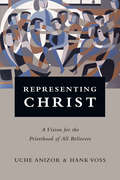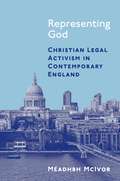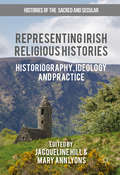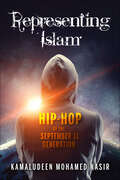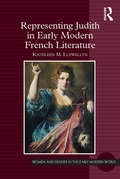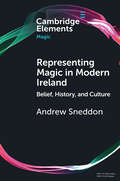- Table View
- List View
Repentances
by Annette MeyersNathan is about to make the last payment on his wife and daughter's passage to America. The ship bringing his wife and child to America is already at sea, but Miri and Rayzela are not on board.
Repetition: Past Lives, Life, And Rebirth
by Doris Eliana CohenThis fascinating book by Doris Eliana Cohen, Ph.D., was written to help us create a shift in our own consciousness as well as that of humanity. In order to heal from traumas, we unknowingly repeat the stories of our lives again and again, reliving them in different scenarios in this life as well as in other lifetimes. <P><P> This repetition of our behavior patterns is neither neurotic nor pathological. It is absolutely necessary, because painful though it may be, repetition offers us multiple opportunities for facing our issues, making new choices, and healing ourselves at last. <P><P>All of us have a God-given gift of free choice, although we may be unaware of it at times. Only when we acknowledge and take full responsibility for the choices we’ve made in our current and past lives can we begin to change our stories and end the suffering we’ve been causing ourselves. <P><P>This material is based on Doris’s 30 years of clinical experience with patients, using traditional therapy techniques combined with past-life regression therapy. It is guided and inspired by her communication with Guides and Angels of the Light, who have accompanied her for many years. Within these pages, Doris presents the 7 Steps of Rebirth, which provide a profound yet swift and simple route to change our lives and heal ourselves. Her 4 Steps of Joy offer a powerful tool for accessing the Light swiftly and easily. <P><P><P> Remembering the events of our past lives provides a rich and fascinating tapestry of our journey, resulting in the humbling and uplifting realization that our souls are on a grand adventure. In owning our stories, we move from seeing ourselves as victims of life to empowering ourselves as co-creators of our destiny.
Replacing Darwin: The NEW Origin of Species
by Nathaniel T JeansonIf Darwin were to examine the evidence today using modern science, would his conclusions be the same? Charles Darwin’s On the Origin of Species, published over 150 years ago, is considered one of history’s most influential books and continues to serve as the foundation of thought for evolutionary biology. Since Darwin’s time, however, new fields of science have immerged that simply give us better answers to the question of origins. With a Ph.D. in cell and developmental biology from Harvard University, Dr. Nathaniel Jeanson is uniquely qualified to investigate what genetics reveal about origins. The Origins Puzzle Comes Together If the science surrounding origins were a puzzle, Darwin would have had fewer than 15% of the pieces to work with when he developed his theory of evolution. We now have a much greater percentage of the pieces because of modern scientific research. As Dr. Jeanson puts the new pieces together, a whole new picture emerges, giving us a testable, predictive model to explain the origin of species. A New Scientific Revolution Begins Darwin’s theory of evolution may be one of science’s “sacred cows,” but genetics research is proving it wrong. Changing an entrenched narrative, even if it’s wrong, is no easy task. Replacing Darwin asks you to consider the possibility that, based on genetics research, our origins are more easily understood in the context of . . . In the beginning . . . God, with the timeline found in the biblical narrative of Genesis. There is a better answer to the origins debate than what we have been led to believe. Let the revolution begin! About the Author Dr. Nathaniel Jeanson is a scientist and a scholar, trained in one of the most prestigious universities in the world. He earned his B.S. in Molecular Biology and Bioinformatics from the University of Wisconsin-Parkside and his PhD in Cell and Developmental Biology from Harvard University. As an undergraduate, he researched the molecular control of photosynthesis, and his graduate work involved investigating the molecular and physiological control of adult blood stem cells. His findings have been presented at regional and national conferences and have been published in peer-reviewed journals, such as Blood, Nature, and Cell. Since 2009, he has been actively researching the origin of species, both at the Institute for Creation Research and at Answers in Genesis.
Replant
by Darrin Patrick Mark DevineGrow Where You're Replanted Today's spiritual landscape is littered with churches on their last legs, forcing us to reconsider how we keep the Body of Christ alive and strong. The solution, according to visionary pastors Darrin Patrick and Mark DeVine, is to infuse new blood into the body and by seeking God's presence and guidance. Avoiding cookie-cutter steps or how-to formulas, Replant describes the story of a church resurrection, a story that offers a multitude of divinely inspired, and practical possibilities for church planters. The result is a harvest of inspiring ideas on how to inspire new church growth. Discover a new openness to churches merging with other congregations, changing leadership, and harvesting fresh spiritual fruit--inviting us all to re-think how churches not only survive, but thrive.
Replenishing the Earth Spiritual Valued for Healing Ourselves and the World
by Wangari MaathaiAn impassioned call to heal the wounds of our planet and ourselves through the tenets of our spiritual traditions, from a winner of the Nobel Peace Prize. It is so easy, in our modern world, to feel disconnected from the physical earth. Despite dire warnings and escalating concern over the state of our planet, many people feel out of touch with the natural world. Nobel laureate Wangari Maathai has spent decades working with the Green Belt Movement to help women in rural Kenya plant--and sustain--millions of trees. With their hands in the dirt, these women often find themselves empowered and "at home" in a way they never did before. Maathai wants to impart that feeling to everyone, and believes that the key lies in traditional spiritual values: love for the environment, self-betterment, gratitude and respect, and a commitment to service. While educated in the Christian tradition, Maathai draws inspiration from many faiths, celebrating the Jewish mandate tikkun olam ("repair the world") and renewing the Japanese term mottainai ("don't waste"). Through rededication to these values, she believes, we might finally bring about healing for ourselves and the earth.
Replicate: How to Create a Culture of Disciple-Making Right Where You Are
by Robby Gallaty Chris Swain"Replicate shows church leaders how to make disciples who make disciples and get the rest of your church on board. Learn the five marks of a healthy disciplemaking church, how to influence culture, uproot misconceptions of the gospel, and change your church and community." <p>-- Provided by publisher.
Replicate: How to Create a Culture of Disciple-Making Right Where You Are
by Robby Gallaty Chris SwainA Practical Guide to Creating and Sustaining a Culture of Disciple-Making in Any ChurchOver the last few decades American churches have produced plenty of converts but not as many mature believers. Studies show the majority of Christians don&’t even understand the basics of faith. But how do you tackle such a big problem?Replicate shows church leaders how to make disciples who make disciples and get the rest of your church on board as well. This one-on-one relational ministry is how Jesus laid the foundation for His church that is still growing today, and it&’s how we continue the work in our own local congregations. Learn the five marks of a healthy disciple-making church, how to influence culture, uproot misconceptions of the church and the gospel, and change your church and community. No more focusing on mere numbers, it&’s time to grow in maturity and through multiplication.
Replicate: How to Create a Culture of Disciple-Making Right Where You Are
by Robby Gallaty Chris SwainA Practical Guide to Creating and Sustaining a Culture of Disciple-Making in Any ChurchOver the last few decades American churches have produced plenty of converts but not as many mature believers. Studies show the majority of Christians don&’t even understand the basics of faith. But how do you tackle such a big problem?Replicate shows church leaders how to make disciples who make disciples and get the rest of your church on board as well. This one-on-one relational ministry is how Jesus laid the foundation for His church that is still growing today, and it&’s how we continue the work in our own local congregations. Learn the five marks of a healthy disciple-making church, how to influence culture, uproot misconceptions of the church and the gospel, and change your church and community. No more focusing on mere numbers, it&’s time to grow in maturity and through multiplication.
Replication: The Jason Experiment
by Jill WilliamsonWhat if everything you knew was a lie? Martyr-otherwise known as Jason 3:3-is one of hundreds of clones kept in a remote facility called Jason Farms. Told that he has been created to save humanity, Martyr has just one wish before he is scheduled to "expire" in less than a month. To see the sky. Abby Goyer may have just moved to Alaska, but she has a feeling something strange is going on at the farm where her father works. But even this smart, confident girl could never have imagined what lies beneath a simple barn. Or what would happen when a mysterious boy shows up at her door, asking about the stars. As the reality of the Jason Experiment comes to light, Martyr is caught between two futures-the one for which he was produced and the one Abby believes God created him to have. Time is running out, and Martyr must decide if a life with Abby is worth leaving everything he's ever known.
Report on the Church: Catholicism After Vatican II
by Richard P. McbrienThe author reviews the changes brought by Vatican II and then explores specific areas of interest including Catholics in Conflict, Ordained Ministry, Laypersons in the Church, Women in the Church, Church and Society, Church and Politics, Ecumenism, Personalities, Popes, and the future of the church.
Reports from the Zen Wars: The Impossible Rigor of a Questioning Life
by Steve AntinoffFour decades ago -- aged twenty -- the author experienced what he calls a "negative satori," a fundamental and irrefutable realization not of enlightenment, but of himself as a predicament only enlightenment could resolve. This, shaped by the hammer blows of a singular American professor, Richard DeMartino, brought him to Zen, and to Japan. Yet over time, of far greater import than his bungling efforts were the wonderful occupants of the Zen world he encountered: Toyoshima-san, the meditation Prometheus whose superhuman efforts astounded and inspired all while he remained impaled on the cliff's edge; the Thief, chief monastery monk who stole the world from whoever he encountered and whose yawns and the brushing of his teeth shot sparks of Absolute Meaning; Hisamatsu, the great lay Zen Master who at age 16 overheard a doctor tell his mother he'd be dead in six months, only to awaken ten years later and become the most delighted man in Japan; Bunko, the monk kind to others but ferocious with himself, whose daily state of Oneness in meditation left him dissatisfied because despite all exertion he could not crush it to pieces and break beyond it.These are among the sitters for the portraits in Reports From the Zen Wars, Steve Antinoff's attempt to bear witness to what for him has been The Greatest Show on Earth, price of admission one lotus position.
Reposicionarse para un mayor éxito
by Ikechukwu JosephReposicionarse para un mayor éxito (Crear prosperidad a partir de la adversidad) es una gran guía para aquellos que quieren tener éxito en la vida, la carrera, la profesión o el ministerio, superando los desafíos de la vida. Aprenda las herramientas de reposicionamiento, reajuste de la reflexión, reequipamiento, reordenación, retrospección, reagrupación, reprensión, redención, reforma, acceso, ensayo, reconciliación, regeneración, resolución, reingeniería.
Reposition Yourself Reflections
by T. D. JakesT.D. Jakes offers readers of the New York Times bestseller Reposition Yourself: Living Life Without Limits a collection of scripture and quotes that provides the spiritual underpinnings of his message about applying Christian principles to adjust to the many changes that life brings. Reposition Yourself, the narrative book, uses wisdom collected from more than thirty years of Jakes's experience counseling and working with high-profile and everyday people on financial, relational, and spiritual creativity on the path to an enriched life filled with contentment at every stage. Reposition Yourself Reflections collects the words that ground Reposition Yourself solidly in biblical teachings. Reflections is an essential keepsake, to carry with you in moments when inspiration and encouragement are needed.
Reposition Yourself: Living Life Without Limits
by T.D. JakesLife should be full of success, spirituality, and happy relationships, but we often settle for less—Reposition Yourself is a guide for living a more prosperous life through Christian principles.The star of BET&’s Mind, Body & Soul, and featured guest speaker on Oprah&’s Lifeclass, Potters House pastor T.D. Jakes offers readers the New York Times bestselling Reposition Yourself: Living Life Without Limits, an inspirational narrative self-help book that provides the spiritual underpinnings of his message about applying Christian principles to adjust to the many changes that life brings. In the vein of Joel Osteen&’s Become a Better You and Dr. Phil&’s Life Strategies, Reposition Yourself uses wisdom collected from more than thirty years of Jakes&’s experience counseling and working with high-profile and everyday people on financial, relational, and spiritual creativity on the path to an enriched life filled with contentment at every stage.
Repossessed
by A. M. JenkinsDon't call me a demon. I prefer the term Fallen Angel. Everybody deserves a vacation, right? Especially if you have a pointless job like tormenting the damned. So who could blame me for blowing off my duties and taking a small, unauthorized break? Besides, I've always wanted to see what physical existence is like. That's why I "borrowed" the slightly used body of a slacker teen. Believe me, he wasn't going to be using it anymore anyway. I have never understood why humans do the things they do. Like sin-if it's so terrible, why do they keep doing it? I'm going to have a lot of fun finding out!
Representation of Deities of the Maya Manuscript
by Paul SchellhasThe three manuscripts which we possess of the ancient Maya peoples of Central America, the Dresden (Dr.), the Madrid (Tro.-Cort.) and the Paris (Per.) manuscripts, all contain a series of pictorial representations of human figures, which, beyond question, should be regarded as figures of gods. Together with these are a number of animal figures, some with human bodies, dress and armor, which likewise have a mythologic significance
Representations of Dalit Protagonists: Indian English Fiction and Marathi Dalit Literature
by Hanumant Ajinath LokhandeThis book interrogates canonical Indian English fiction which has Dalit characters as protagonists or major characters, and argues that the representation of such characters, although well-meant, is regulated and made unremarkable. It examines how the normative discourse of the Anglophone novel portrays Dalits from an upper-caste point of view, devoid of Ambedkarite or Dalit consciousness, and thus implicitly reinscribes the upper caste power by restricting the narrative to merely represent Dalit submission and victimhood. The arguments then are substantiated by setting up a comparative framework through contrastive analysis of selected narratives by Dalit writers from Marathi Dalit literature to highlight the differential representational paradigms that mark the absence or presence of Ambedkarite consciousness and perspective.
Representations of Eve in Antiquity and the English Middle Ages (Routledge Studies in Medieval Religion and Culture)
by John FloodAs the first woman, Eve was the pattern for all her daughters. The importance of readings of Eve for understanding how women were viewed at various times is a critical commonplace, but one which has been only narrowly investigated. This book systematically explores the different ways in which Eve was understood by Christians in antiquity and in the English Middle Ages, and it relates these understandings to female social roles. The result is an Eve more various than she is often depicted by scholars. Beginning with material from the bible, the Church Fathers and Jewish sources, the book goes on to look at a broad selection of medieval writing, including theological works and literary texts in Old and Middle English. In addition to dealing with famous authors such as Augustine, Aquinas, Dante and Chaucer, the writings of authors who are now less well-known, but who were influential in their time, are explored. The book allows readers to trace the continuities and discontinuities in the way Eve was portrayed over a millennium and a half, and as such it is of interest to those interested in women or the bible in the Middle Ages.
Representations of the Body in Middle English Biblical Drama (The New Middle Ages)
by Estella CiobanuRepresentations of the Body in Middle English Biblical Drama combines epistemological enquiry, gender theory and Foucauldian concepts to investigate the body as a useful site for studying power, knowledge and truth. Intertwining the conceptualizations of violence and the performativity of gender identity and roles, Estella Ciobanu argues that studying violence in drama affords insights into the cultural and social aspects of the later Middle Ages. The text investigates these biblical plays through the perspective of the devil and offers a unique lens that exposes medieval disquiets about Christian teachings and the discourse of power. Through detailed primary source analysis and multidisciplinary scholarship, Ciobanu constructs a text that interrogates the significance of performance far beyond the stage.
Representing Christ: A Vision for the Priesthood of All Believers
by Uche Anizor Hank VossThe priesthood of all believers is a core Protestant belief. But what does it actually mean? Uche Anizor and Hank Voss set the record straight in this concise treatment of a doctrine that lies at the center of church life and Christian spirituality. The authors look at the priesthood of all believers in terms of the biblical witness, the contribution of Martin Luther and the doctrine of the Trinity. They place this concept in the context of the canonical description of Israel and the church as a royal priesthood that responds to God in witness and service to the world. Representing Christ is much more than a piece of Reformation history. It shows that the priesthood of all believers is interwoven with the practical, spiritual and missional life of the church.
Representing God: Christian Legal Activism in Contemporary England
by Méadhbh McIvorHow evangelical activism in England contributes to the secularizing forces it seeks to challengeOver the past two decades, a growing number of Christians in England have gone to court to enforce their right to religious liberty. Funded by conservative lobby groups and influenced by the legal strategies of their American peers, these claimants—registrars who conscientiously object to performing the marriages of same-sex couples, say, or employees asking for exceptions to uniform policies that forbid visible crucifixes—highlight the uneasy truce between law and religion in a country that maintains an established Church but is wary of public displays of religious conviction.Representing God charts the changing place of public Christianity in England through the rise of Christian political activism and litigation. Based on two years of fieldwork split between a conservative Christian lobby group and a conservative evangelical church, Méadhbh McIvor explores the ideas and contested reception of this ostensibly American-inspired legal rhetoric. She argues that legal challenges aimed at protecting “Christian values” ultimately jeopardize those values, as moralities woven into the fabric of English national life are filtered from their quotidian context and rebranded as the niche interests of a cultural minority. By framing certain moral practices as specifically Christian, these activists present their religious convictions as something increasingly set apart from broader English culture, thereby hastening the secularization they seek to counter.Representing God offers a unique look at how Christian politico-legal activism in England simultaneously responds to and constitutes the religious life of a nation.
Representing Irish Religious Histories
by Jacqueline Hill Mary Ann LyonsThis collection begins on the premise that, until recently, religion has been particularly influential in Ireland in forming a sense of identity, and in creating certain versions of reality. History has also been a key component in that process, and the historical evolution of Christianity has been appropriated by the main religious denominations - Catholic, Church of Ireland, and Presbyterian - with a view to reinforcing their own identities. This book explores the ways in which this occurred; the writing of religious history, and some of the manifestations of that process, forms key parts of the collection. Also included are chapters discussing current and recent attempts to examine the legacy of collective religious memory - notably in Northern Ireland - based on projects designed to encourage reflection about the religious past among both adults and school-children. Readers will find this collection particularly timely in view of the current 'decade of commemorations'.
Representing Islam: Hip-Hop of the September 11 Generation (Framing the Global)
by Kamaludeen Mohamed NasirHow do Muslims who grew up after September 11 balance their love for hip-hop with their devotion to Islam? How do they live the piety and modesty called for by their faith while celebrating an art form defined, in part, by overt sexuality, violence, and profanity? In Representing Islam, Kamaludeen Mohamed Nasir explores the tension between Islam and the global popularity of hip-hop, including attempts by the hip-hop ummah, or community, to draw from the struggles of African Americans in order to articulate the human rights abuses Muslims face. Nasir explores state management of hip-hop culture and how Muslim hip-hoppers are attempting to "Islamize" the genre's performance and jargon to bring the music more in line with religious requirements, which are perhaps even more fraught for female artists who struggle with who has the right to speak for Muslim women. Nasir also investigates the vibrant underground hip-hop culture that exists online. For fans living in conservative countries, social media offers an opportunity to explore and discuss hip-hop when more traditional avenues have been closed. Representing Islam considers the complex and multifaceted rise of hip-hop on a global stage and, in doing so, asks broader questions about how Islam is represented in this global community.
Representing Judith in Early Modern French Literature (Women And Gender In The Early Modern World Ser.)
by Kathleen M. LlewellynAlthough attention to the Book of Judith and its heroine has grown in recent years, this is the first full-length study to focus on adaptations of the Bible’s Old Testament Book of Judith across a range of literary genres written in French during the early modern era. Author Kathleen Llewellyn bases her analysis on references to Judith in a number of early modern sermons as well as the ’Judith’ texts of four early modern writers. The texts include two theatrical dramas, Le Mystère de Judith et Holofernés (c. 1500), believed to have been written by Jean Molinet, and Le Miroir des vefves: Tragédie sacrée d'Holoferne & Judith by Pierre Heyns (1596), as well as two epic poems, La Judit (1574) by Guillaume de Salluste Du Bartas, and Gabrielle de Coignard’s Imitation de la victoire de Judich (1594). Llewellyn’s goal is to see Judith as she was envisioned by early modern French writers and their readers, and to understand how the sixteenth century shaped their view of the heroine. Noting aspects of that story that were emphasized by sixteenth-century authors, as well as elements that those writers altered to suit their purposes, she also examines the ways in which writers of this era made use of Judith’s story as a means to explore interests and concerns of early modern writers, readers, and spectators. Representing Judith in Early Modern French Literature provides a deeper understanding of early modern ideas regarding the role of women, the use of exemplary stories in preaching and teaching, theories of vision, and the importance of community in Renaissance France.
Representing Magic in Modern Ireland: Belief, History, and Culture (Elements in Magic)
by Andrew SneddonThis Element argues that Ireland did not experience a disenchanted modernity, nor a decline in magic. It suggests that beliefs, practices and traditions concerning witchcraft and magic developed and adapted to modernity to retain cultural currency until the end of the twentieth century. This analysis provides the backdrop for the first systematic exploration of how historic Irish trials of witches and cunning-folk were represented by historians, antiquarians, journalists, dramatists, poets, and novelists in Ireland between the late eighteenth and late twentieth century. It is demonstrated that this work created an accepted narrative of Irish witchcraft and magic which glossed over, ignored, or obscured the depth of belief in witchcraft, both in the past and in contemporary society. Collectively, their work gendered Irish witchcraft, created a myth of a disenchanted, modern Ireland, and reinforced competing views of Irishness and Irish identity. These long-held stereotypes were only challenged in the late twentieth-century.
